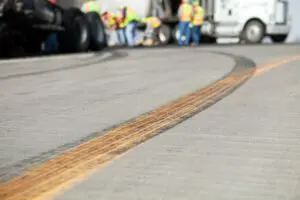What to Do If a Truck Leaves the Scene of a Crash?
What Can You Do if a Truck Driver Leaves the Scene of an Accident?
 Becoming a victim of a hit and run crash with a truck is a traumatic experience. Truck crashes are increasing in frequency and truck drivers who are “at fault” are more often guilty of leaving the scene of an accident than in the past.
Becoming a victim of a hit and run crash with a truck is a traumatic experience. Truck crashes are increasing in frequency and truck drivers who are “at fault” are more often guilty of leaving the scene of an accident than in the past.
Leaving the scene of an accident isn’t a wise decision. It is a crime that normally results in a more serious penalty than those normally imposed for causing an accident. A driver who flees an accident scene may lose his or her license and/or receive a prison sentence.
Yet many drivers, in the heat of the moment, flee for a variety of reasons. Sometimes they may leave an accident site unintentionally, unaware they caused damage or injury.
Victims of hit-and-run truck accidents often suffer serious, […]
Read MoreWhat Percentage of Truck Accidents are Caused by Cars?
What Happens When a Car Driver is Responsible for a Truck Accident?
Truck drivers are the heart of America’s infrastructure. In 2020, 10.23 billion tons of freight was transported by trucks in the United States. Food, construction materials, raw materials for U.S. manufacturers, and every vital retail goods sold and shipped in the U.S. relies on big rigs. More than 72 percent of transported items in this country are moved by trucks. The U.S. economy is driven by large trucks. But what happens if you are a truck driver involved in a large truck crash and you are not at fault?
At Munley Law Personal Injury Attorneys, we know picking up the pieces after a truck accident can feel like an insurmountable task. If you or a loved one becomes a victim of a truck accident caused by a passenger vehicle or other motorist, our highly experienced and dedicated truck accident lawyers are ready to help you. […]
Read MoreHow to Prove Your Truck Crash Case at Trial
Do you know what it takes to prove your truck crash case?
The nation’s #1 tractor-trailer accident lawyers explain how to win your semi-truck collision claim at trial

If there’s one thing we know at Munley Law Personal Injury Attorneys, it’s how to win a truck crash case at trial. When it comes to personal injury law, only a small percentage of attorneys have the experience, resources, and qualifications to handle a truck accident case. Of those attorneys, only an elite few have the courtroom experience to win your truck case at trial. At Munley Law Personal Injury Attorneys, we know how to prove liability and damages in order to get you the compensation you are rightfully owed.
Call today for a free, confidential consultation with one of the nation’s leading truck accident lawyers.
Why bring a truck accident lawsuit to trial
According to the most recent Federal Motor Carrier Safety Administration report, […]
Read MoreHow Do Truck Drivers Get Paid?
Truck Accident Attorneys at Munley Law Personal Injury Attorneys explain truck driver pay and job-related hazards
 Truck drivers are essential to our economy and should be compensated as such. While truck driving can be a good way to make a living, it is not without risks. Many trucking and transportation companies prioritize safety and the well-being of their workers; however, some companies push their drivers to physical and financial limits, which can have disastrous effects on driver safety. As truck accident attorneys, we represent many truck drivers who have been hurt on the job. A truck accident attorney knows how trucking company practices and safety violations can put truckers at risk. In this article, our truck accident lawyers will outline the various ways truck driver pay is determined, and highlight important links between driver pay and highway safety.
Truck drivers are essential to our economy and should be compensated as such. While truck driving can be a good way to make a living, it is not without risks. Many trucking and transportation companies prioritize safety and the well-being of their workers; however, some companies push their drivers to physical and financial limits, which can have disastrous effects on driver safety. As truck accident attorneys, we represent many truck drivers who have been hurt on the job. A truck accident attorney knows how trucking company practices and safety violations can put truckers at risk. In this article, our truck accident lawyers will outline the various ways truck driver pay is determined, and highlight important links between driver pay and highway safety.
What is the average truck driver’s salary? […]
Read MorePosted in Truck Accidents.
What to Do After a Truck Accident
We know that if you or a loved have been injuried in a truck accident, you may have many questions. You may be wondering what to do after a truck accident. An experienced truck accident lawyer at Munley Law Personal Injury Attorneys can answer your questions. We’ve answered some of the most frequently asked questions here. You can also call us at 844.385.7535 for a free case evaluation where we can discuss the specific details of your truck crash. We will help you understand your rights and what you need to do.
Steps to Take After a Truck Accident Happened
In the immediate aftermath of a truck accident, there are things to do at the accident scene if you are able. The steps to take include:

- Remain calm
- Stay in your vehicle if it is safe to do so
- Turn on your hazard lights
- Use your cell phone to call 911, […]









